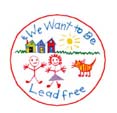|
Click on photo to view larger image


|
Although lead poisoning affects hundreds of thousands of children annually, it is preventable. Children are at the greatest risk for lead poisoning from birth to age six, when their neurological systems are developing. October 22, 2006, marks the beginning of Maryland’s 19th annual Lead Poisoning Prevention Week. In conjunction with the nation’s eigth annual lead week observation, it is the highlight of the Maryland Department of the Environment’s (MDE) year-long education and outreach program. Lead poisoning prevention week is designed to raise awareness among landlords, parents, tenants, and homeowners about what they can do to reduce the risk of lead poisoning.
The Covert Culprit
With no obvious symptoms, lead poisoning frequently goes unrecognized and can affect nearly every system in the body. Left untreated it can cause learning disabilities, behavioral problems, and, at very high levels, seizures, coma, and even death. Organized by the Lead Poisoning Prevention Program (LPPP) and partners such as the Coalition to End Childhood Lead Poisoning, local health and environmental departments, the Assistant Attorney General assigned to the LPPP, MDE, the Department of Health and Mental Hygiene, and the Department of Housing and Community Development, the lead week celebration marks the culmination of an outreach program that reaches over one million citizens each year.
The primary source of lead exposure among U.S. children is lead-based paint and lead-contaminated dust found in deteriorating buildings or homes undergoing renovation. It is ingested through children's normal hand-to-mouth activity. Lead-based paints were banned for use in housing in 1978. However, approximately 24 million housing units in the United States have deteriorated leaded paint and elevated levels of lead-contaminated house dust. According to the U.S. Census Bureau 2004 American Community Survey, 95 percent of the 449,000 Maryland residential homes built before 1950 contain lead paint, while 75 percent of the 972,000 houses built between 1950-1979 are likely to have lead paint.
Low-level “background” lead exposure from water, air, and soil and with imported products may cause lead exposure among children, but these levels are rarely dangerous. Recently, MDE and the Baltimore City Health Department issued a press release to alert the public about the dangers of lead contamination in children’s jewelry and the cosmetic black powdered substance called Surma or Kohl as current sources of lead poisoning. The Baltimore City Commissioner of Health had certain jewelry and Kohl removed from the shelves of stores in Baltimore City.
Approximately 310,000 U.S. children aged 1-5 years have blood lead levels greater than the Centers for Disease Control recommended level of 10 micrograms of lead per deciliter of blood. Of the 99,148 Maryland children who received a blood lead test in 2005, 1,331 of them tested positive at this level of concern.
Maryland’s Lead Prevention Law
Maryland’s Environment Article Title 6, Subtitle 8 is one of the few primary prevention laws in the nation that has worked to drastically reduce children’s exposure to lead-based paint in Maryland’s pre-1950 rental properties. Under the 1994 law, MDE assures compliance with mandatory requirements for lead risk reduction in rental units built before 1950. Maryland maintains a statewide listing of registered and inspected units, and provides blood lead surveillance through a registry of all children tested in the state. The “100 percent rule” of the law that became effective in February 2006, extends this requirement to all pre-1950 residential rental properties regardless of whether there has ever been a change in occupancy. Currently, 85 percent of property owners obtained at least one Full Risk Reduction Lead Inspection Certificate. In fiscal year 2006, 18,000 new registrations were added to the registry, resulting in 87 percent of pre-1950 housing units are registered or certified as lead free.
The key to preventing lead poisoning is limiting children’s exposure to lead and prompt diagnosis and treatment of children suspected of having come into contact with lead. If you are concerned about your child being exposed to lead:
-
ask a doctor to test your child
-
-
talk to lead experts at MDE’s Lead Hotline (410-537-4199) or at the Coalition to End Childhood Lead Poisoning (410-534-6447) about testing paint and dust from your home for lead if you live in a house or apartment built before 1978
-
damp-mop floors, damp-wipe surfaces, and frequently wash a child’s hands, pacifiers, and toys
-
use only cold water from the tap for drinking, cooking, and for making baby formula. Hot water is more likely to contain higher levels of lead, and most of the lead in household water usually comes from the plumbing in your house, not from the local water supply
-
remove any lead hazards in a child’s environment
-
avoid using home remedies (such as azarcon, greta, pay-loo-ah) and cosmetics (such as kohl, alkohl) that contain lead
-
take basic steps to decrease your exposure to lead (e.g., showering and changing clothes after high-risk tasks).
Click here for more information on Maryland’s Lead Poisoning Prevention Program please call the Lead Poisoning Prevention Program at 410-537-3942 or 800-776-2706.
|